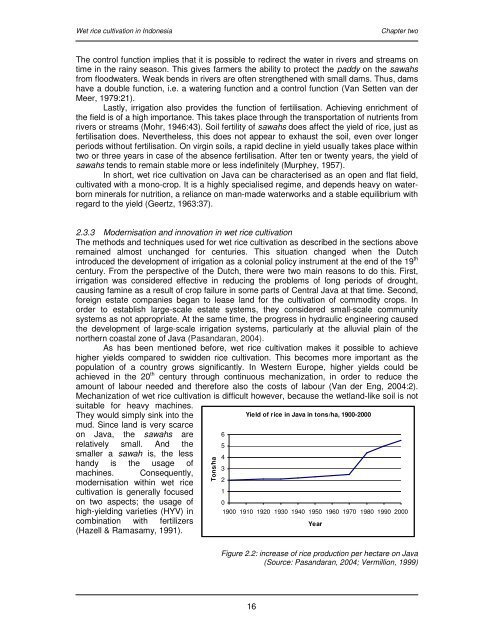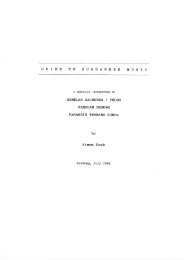Wet rice cultivation in Indonesia - Free EBooks Library
Wet rice cultivation in Indonesia - Free EBooks Library
Wet rice cultivation in Indonesia - Free EBooks Library
Create successful ePaper yourself
Turn your PDF publications into a flip-book with our unique Google optimized e-Paper software.
<strong>Wet</strong> <strong>rice</strong> <strong>cultivation</strong> <strong>in</strong> <strong>Indonesia</strong> Chapter two<br />
The control function implies that it is possible to redirect the water <strong>in</strong> rivers and streams on<br />
time <strong>in</strong> the ra<strong>in</strong>y season. This gives farmers the ability to protect the paddy on the sawahs<br />
from floodwaters. Weak bends <strong>in</strong> rivers are often strengthened with small dams. Thus, dams<br />
have a double function, i.e. a water<strong>in</strong>g function and a control function (Van Setten van der<br />
Meer, 1979:21).<br />
Lastly, irrigation also provides the function of fertilisation. Achiev<strong>in</strong>g enrichment of<br />
the field is of a high importance. This takes place through the transportation of nutrients from<br />
rivers or streams (Mohr, 1946:43). Soil fertility of sawahs does affect the yield of <strong>rice</strong>, just as<br />
fertilisation does. Nevertheless, this does not appear to exhaust the soil, even over longer<br />
periods without fertilisation. On virg<strong>in</strong> soils, a rapid decl<strong>in</strong>e <strong>in</strong> yield usually takes place with<strong>in</strong><br />
two or three years <strong>in</strong> case of the absence fertilisation. After ten or twenty years, the yield of<br />
sawahs tends to rema<strong>in</strong> stable more or less <strong>in</strong>def<strong>in</strong>itely (Murphey, 1957).<br />
In short, wet <strong>rice</strong> <strong>cultivation</strong> on Java can be characterised as an open and flat field,<br />
cultivated with a mono-crop. It is a highly specialised regime, and depends heavy on waterborn<br />
m<strong>in</strong>erals for nutrition, a reliance on man-made waterworks and a stable equilibrium with<br />
regard to the yield (Geertz, 1963:37).<br />
2.3.3 Modernisation and <strong>in</strong>novation <strong>in</strong> wet <strong>rice</strong> <strong>cultivation</strong><br />
The methods and techniques used for wet <strong>rice</strong> <strong>cultivation</strong> as described <strong>in</strong> the sections above<br />
rema<strong>in</strong>ed almost unchanged for centuries. This situation changed when the Dutch<br />
<strong>in</strong>troduced the development of irrigation as a colonial policy <strong>in</strong>strument at the end of the 19 th<br />
century. From the perspective of the Dutch, there were two ma<strong>in</strong> reasons to do this. First,<br />
irrigation was considered effective <strong>in</strong> reduc<strong>in</strong>g the problems of long periods of drought,<br />
caus<strong>in</strong>g fam<strong>in</strong>e as a result of crop failure <strong>in</strong> some parts of Central Java at that time. Second,<br />
foreign estate companies began to lease land for the <strong>cultivation</strong> of commodity crops. In<br />
order to establish large-scale estate systems, they considered small-scale community<br />
systems as not appropriate. At the same time, the progress <strong>in</strong> hydraulic eng<strong>in</strong>eer<strong>in</strong>g caused<br />
the development of large-scale irrigation systems, particularly at the alluvial pla<strong>in</strong> of the<br />
northern coastal zone of Java (Pasandaran, 2004).<br />
As has been mentioned before, wet <strong>rice</strong> <strong>cultivation</strong> makes it possible to achieve<br />
higher yields compared to swidden <strong>rice</strong> <strong>cultivation</strong>. This becomes more important as the<br />
population of a country grows significantly. In Western Europe, higher yields could be<br />
achieved <strong>in</strong> the 20 th century through cont<strong>in</strong>uous mechanization, <strong>in</strong> order to reduce the<br />
amount of labour needed and therefore also the costs of labour (Van der Eng, 2004:2).<br />
Mechanization of wet <strong>rice</strong> <strong>cultivation</strong> is difficult however, because the wetland-like soil is not<br />
suitable for heavy mach<strong>in</strong>es.<br />
They would simply s<strong>in</strong>k <strong>in</strong>to the<br />
Yield of <strong>rice</strong> <strong>in</strong> Java <strong>in</strong> tons/ha, 1900-2000<br />
mud. S<strong>in</strong>ce land is very scarce<br />
on Java, the sawahs are 6<br />
relatively small. And the 5<br />
smaller a sawah is, the less 4<br />
handy is the usage of<br />
3<br />
mach<strong>in</strong>es. Consequently,<br />
2<br />
modernisation with<strong>in</strong> wet <strong>rice</strong><br />
<strong>cultivation</strong> is generally focused 1<br />
on two aspects; the usage of 0<br />
high-yield<strong>in</strong>g varieties (HYV) <strong>in</strong> 1900 1910 1920 1930 1940 1950 1960 1970 1980 1990 2000<br />
comb<strong>in</strong>ation with fertilizers<br />
Year<br />
(Hazell & Ramasamy, 1991).<br />
Tons/ha<br />
Figure 2.2: <strong>in</strong>crease of <strong>rice</strong> production per hectare on Java<br />
(Source: Pasandaran, 2004; Vermillion, 1999)<br />
16








